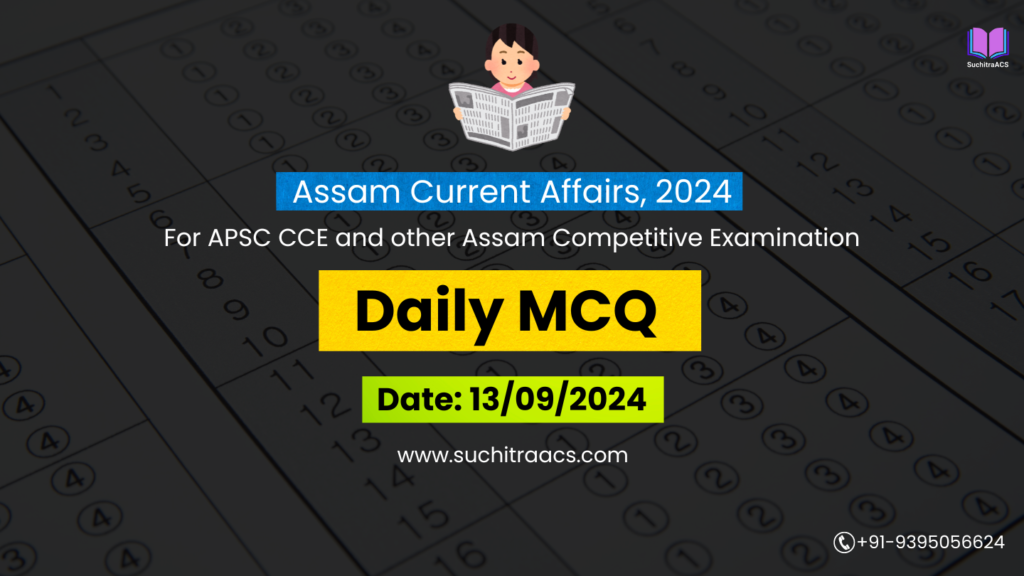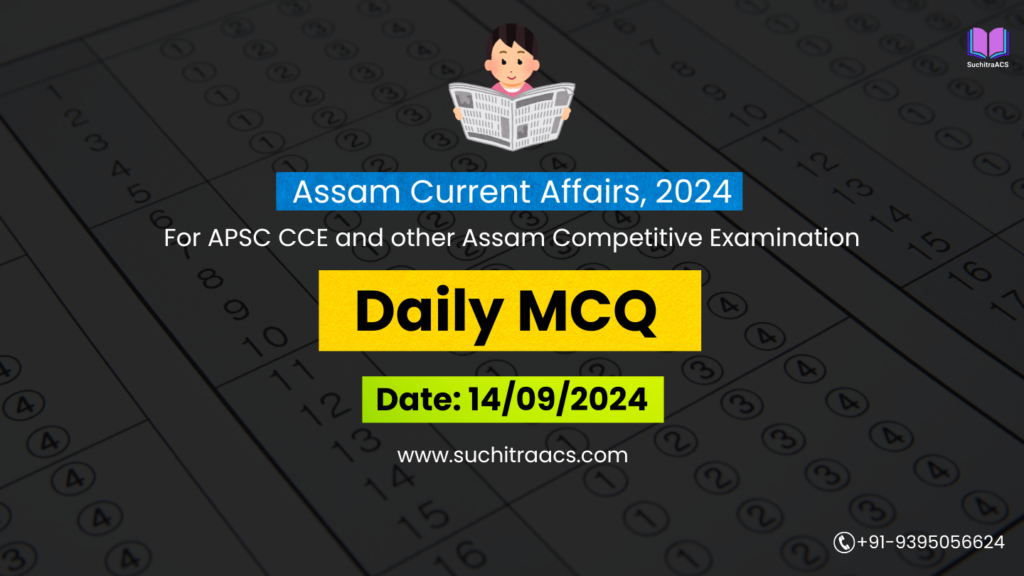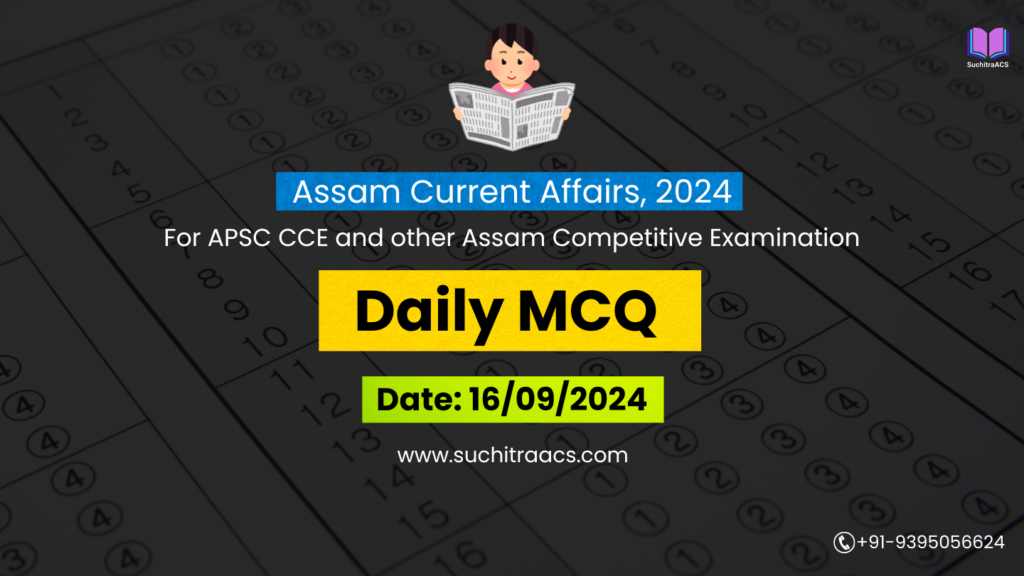APSC MCQs / APSC Prelims Practice Questions based on Assam Tribune (Daily) – 08/01/2025
For APSC CCE and other Assam Competitive examinations aspirants, practicing Daily MCQs is vital. This blog covers most important Prelims questions from the Assam Tribune today (08-01-2025). These issues are key for both APSC Prelims syllabus, offering insights into the important topics of current affairs.
APSC MCQs / APSC Prelims Practice Questions (Date: 08/01/2025)
Topic 1: Earthquake in Tibet and its Regional Impact
- Which of the following regions is part of the Himalayan seismic zone?
- (a) Indo-Gangetic Plain
- (b) Tibetan Plateau
- (c) Western Ghats
- (d) Eastern Coastal Plains
Answer: (b)
Explanation:
The Himalayan seismic zone includes the Tibetan Plateau, which is tectonically active due to the collision of the Indian and Eurasian plates.
- Why are shallow earthquakes more destructive than deeper ones?
- (a) They have higher magnitudes.
- (b) They are closer to the Earth’s surface, causing stronger ground shaking.
- (c) They last longer than deep earthquakes.
- (d) They only occur in densely populated areas.
Answer: (b)
Explanation:
Shallow earthquakes, like the one in Tibet (10 km depth), cause more surface damage due to their proximity to the Earth’s crust.
- What does China’s Level-II emergency response indicate?
- (a) International aid is required for disaster relief.
- (b) The disaster is of a minor scale requiring local resources only.
- (c) National-level resources are mobilized to manage a severe disaster.
- (d) Cross-border evacuation protocols are initiated.
Answer: (c)
Explanation:
A Level-II emergency response in China signifies a severe disaster needing significant national resources.
Topic 2: Indo-Japan Investment Agreement in Assam
- What is the primary objective of the Indo-Japan Investment Agreement in Assam?
- (a) Promote cultural exchange between India and Japan.
- (b) Boost infrastructure and industrial development in Assam.
- (c) Facilitate defense cooperation between India and Japan.
- (d) Develop renewable energy projects in mainland Japan.
Answer: (b)
Explanation:
The agreement focuses on developing infrastructure, industrial clusters, and renewable energy projects in Assam.
- Which of the following is part of Japan’s Free and Open Indo-Pacific strategy?
- (a) Strengthening defense ties with ASEAN nations.
- (b) Enhancing regional connectivity and economic stability.
- (c) Promoting cultural exchanges in the Indo-Pacific.
- (d) Establishing exclusive free trade zones for Japan.
Answer: (b)
Explanation:
Japan’s Free and Open Indo-Pacific strategy emphasizes economic cooperation, regional connectivity, and stability.
- Which rail corridor is part of the Indo-Japan Investment Agreement in Assam?
- (a) Guwahati-Tinsukia
- (b) Guwahati-Silchar
- (c) Siliguri-Dibrugarh
- (d) Itanagar-Tezpur
Answer: (b)
Explanation:
The proposed high-speed rail corridor will link Guwahati and Silchar under the agreement.
Topic 3: India’s Northeast Flood Warning System Expansion
- What is the role of Automated Weather Stations (AWS) in disaster management?
- (a) Predicting earthquakes in tectonic zones.
- (b) Collecting real-time weather data for forecasting.
- (c) Monitoring air pollution levels.
- (d) Providing data for water quality analysis.
Answer: (b)
Explanation:
AWS collect real-time weather data, aiding in accurate flood and rainfall predictions.
- Which of the following rivers is most associated with floods in Northeast India?
- (a) Ganga
- (b) Brahmaputra
- (c) Narmada
- (d) Yamuna
Answer: (b)
Explanation:
The Brahmaputra and its tributaries are highly flood-prone, causing significant damage in Assam and the Northeast.
- Which organization provides technical and financial support for India’s flood warning system in the Northeast?
- (a) UNDP
- (b) World Bank
- (c) NITI Aayog
- (d) IMF
Answer: (b)
Explanation:
The World Bank assists in flood mitigation projects, including early warning systems in the Northeast.
Topic 4: Assam’s Industrial Corridor Initiative
- What is the primary goal of Assam’s Industrial Corridor Initiative?
- (a) Promote eco-tourism in Assam.
- (b) Develop Assam into an economic and industrial hub.
- (c) Build defense infrastructure along the border.
- (d) Strengthen cultural ties with Southeast Asia.
Answer: (b)
Explanation:
The initiative aims to boost Assam’s economy through industrialization and trade integration.
- Which policy complements the Assam Industrial Corridor’s connectivity goals?
- (a) National Urban Transport Policy
- (b) Act East Policy
- (c) National Energy Policy
- (d) Make in India Policy
Answer: (b)
Explanation:
The Act East Policy strengthens trade and connectivity with ASEAN nations, complementing Assam’s industrial initiatives.
- What are Dedicated Freight Corridors (DFCs)?
- (a) Corridors exclusively for passenger trains.
- (b) Railways designed for carrying freight traffic efficiently.
- (c) Highways connecting industrial hubs with ports.
- (d) Special economic zones for freight handling.
Answer: (b)
Explanation:
DFCs are railway projects designed to improve the efficiency of freight transport, essential for industrial corridors.
 APSC Prelims Crash Course, 2025
APSC Prelims Crash Course, 2025
at most affordable rate in Assam!

🔔 Join Our WhatsApp Study Group!
For exclusive access to premium quality content, including study materials, current affairs, MCQs, and model answers for APSC CCE and other Assam competitive exams.
Click here to join: SuchitraACS Study WhatsApp Group
📚 Want to know more about SuchitraACS’s most affordable courses?
Click here to know more: SuchitraACS Courses for APSC CCE and Assam Competitive Examinations




